Introduction
- Geriatric patients’ are more sensitive to medications than younger adults (Resnick, 2016).
- Their drug treatment should differ from that of young people.
- Over-the-counter (OTC) drugs can lead to adverse effects in patients.
- It is necessary to educate patients about OTC drugs.
Patients may purchase over-the-counter (OTC) drugs based on their health care provider’s recommendations. However, individuals can also buy them after reading about them on the Internet or speaking with their friends and relatives. Although the access to these medications is easy, it does not mean that they do not pose any threat to people’s health. Therefore, it is vital for medical professionals to educate people about the benefits and drawbacks of OTC drugs. Older patients should pay significant attention to the medications they are using (Holroyd-Leduc & Reddy, 2012). For example, pharmacies sell a variety of antihistamines – drugs that are used to treat allergies. Older people should be cautious while choosing OTC antihistamines as these drugs affect them strongly.
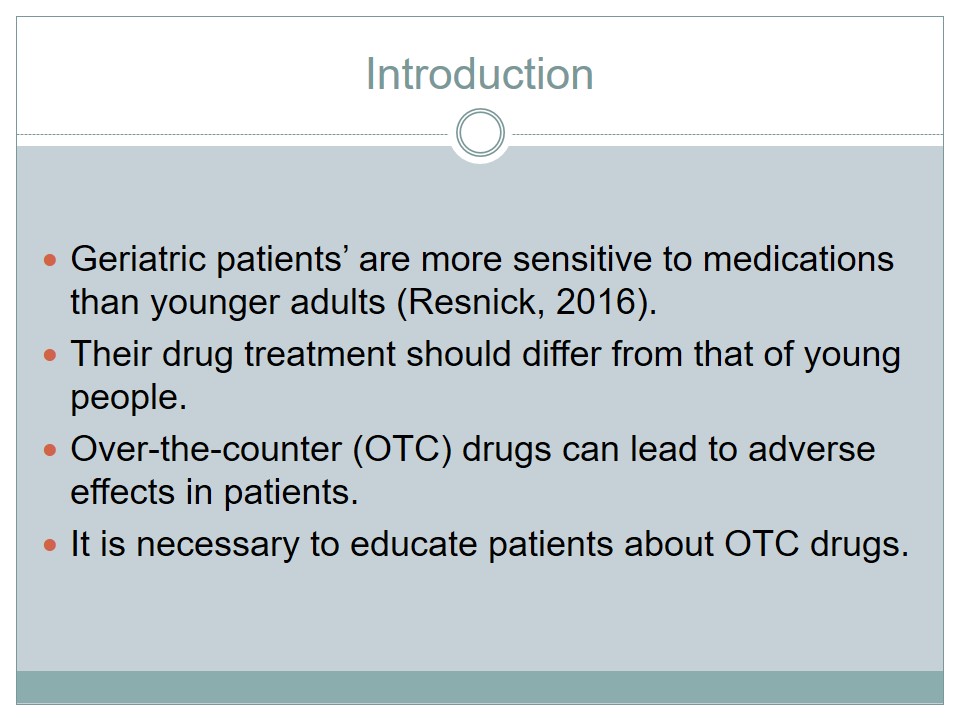
Selected Drug Description
- Antihistamines “block the histamine type 1 (H1) receptors” (NIH, 2017, para. 1).
- They do not block histamine (a mediator of hypersensitivity reactions) but improve its actions.
- Antihistamines’ treat such symptoms as itching, dizziness, nasal stuffiness, urticaria.
- Two main types: first generation (sedating) and second generation (nonsedating) (NIH, 2017).
Antihistamines are drugs that are used to treat allergic reactions, mild sleeping disturbances, and chronic allergic disorders. They block H1 receptors, ameliorating the effects of histamine of the body (NIH, 2017). One can separate antihistamines into two types according to their impact on the central nervous system and blood-brain barrier perfusion ability. The first type is sedating, while the second one is nonsedating. People often used nonsedating antihistamines for longer periods of time than the sedating ones. Other names of these groups are first and second-generation varieties, with some third-generation drugs also becoming available for patients.

Types and Varieties
- Types:
- First-generation drugs (sedating).
- Second- and third-generation drugs (nonsedating).
- Forms:
- Topical: creams, eye drops, gels, nasal sprays.
- Oral: tablets, capsules, liquids.
As it was mentioned before, one can choose from first, second, and third generation antihistamines. The first generation is represented by sedating drugs – these medications can cross the blood-brain barrier (Schellack, Schellack, & van Rensburg, 2015). They cause drowsiness and have a brief period of activity, thus requiring frequent dosing and working as a short-term solution (Schellack et al., 2015). The most popular OTC versions of first-generation antihistamines include drugs with diphenhydramine and chlorpheniramine. Second- and third-generation antihistamines are classified as nonsedating – they do not permeate the blood-brain barrier or have a weaker ability to do than first-generation types. Moreover, they reduce symptoms for longer periods of time and do not cause drowsiness (Schellack et al., 2015). Thus, variations with second-generation antihistamines may work as long-term solutions to reducing the effects of persistent allergic disorders.
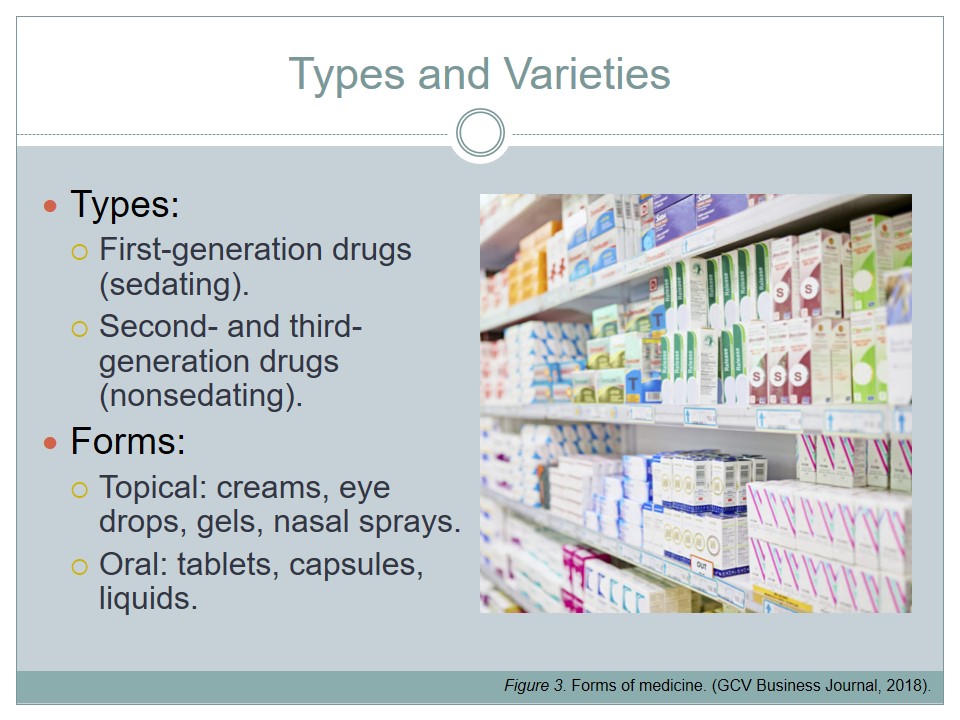
Ingredients
- Main active ingredient:
- Diphenhydramine;
- Chlorpheniramine;
- Cetirizine;
- Loratadine;
- Fexofenadine;
- Additional components:
- Alcohol;
- Pain relievers;
- Decongestants.
Most popular first-generation OTC antihistamines are diphenhydramine and chlorpheniramine. The first one is a part of Benadryl, Banophen, some types of Sudafed, and others. The second one is an active ingredient in Aller-Chlor and Chlor-Trimeton. These varieties can cause drowsiness, headaches, and dry mouth or nose. The first one of these side effects is especially common for Benadryl. It also should be noted that these medications may contain alcohol – thus exacerbating side effects and making them dangerous for older people. Second-generation OTC drugs include such active ingredients as cetirizine (Zyrtec), loratadine (Claritin), and fexofenadine (Allegra). They also relieve allergy symptoms and have side effects that are similar to those of first-generation types. Nevertheless, their dose is usually small, thus lowering the probability of strong side effects occurring. Some medications can have pain relievers and decongestants as additional active ingredients (NIH, 2017).
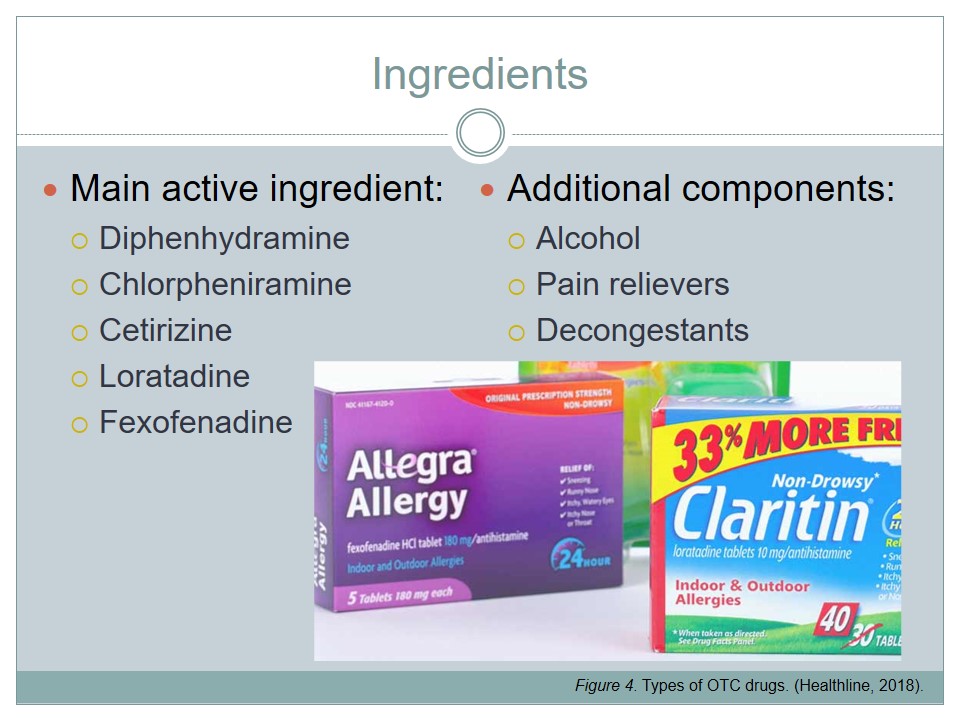
Key Information
- The type of drugs (sedating or nonsedating).
- Active ingredients (antihistamine type, alcohol, pain reliever, decongestant).
- Side effects.
- Patient’s allergic reactions.
- Specific warnings.
- Patient’s medical history and current treatment.
In order to make a clinical decision, a healthcare provider should learn about drugs’ type, ingredients, side effects, precautions, and dosage instructions. For example, first-generation antihistamines are not recommended for children and older adults due to their blood-brain barrier permeation ability (NIH, 2017). Moreover, alcohol-based medications also should be assessed with caution. Drugs that contain other active ingredients should not be suggested to patients who already have similar medicines in their treatment plan to avoid overdosing. It is also vital for one to analyze side effects such as dizziness, vomiting, and allergic reactions. Finally, warnings should be taken into consideration. For instance, chlorpheniramine can cause heart palpitations, urinary retention, and constipation (Schellack et al., 2015).
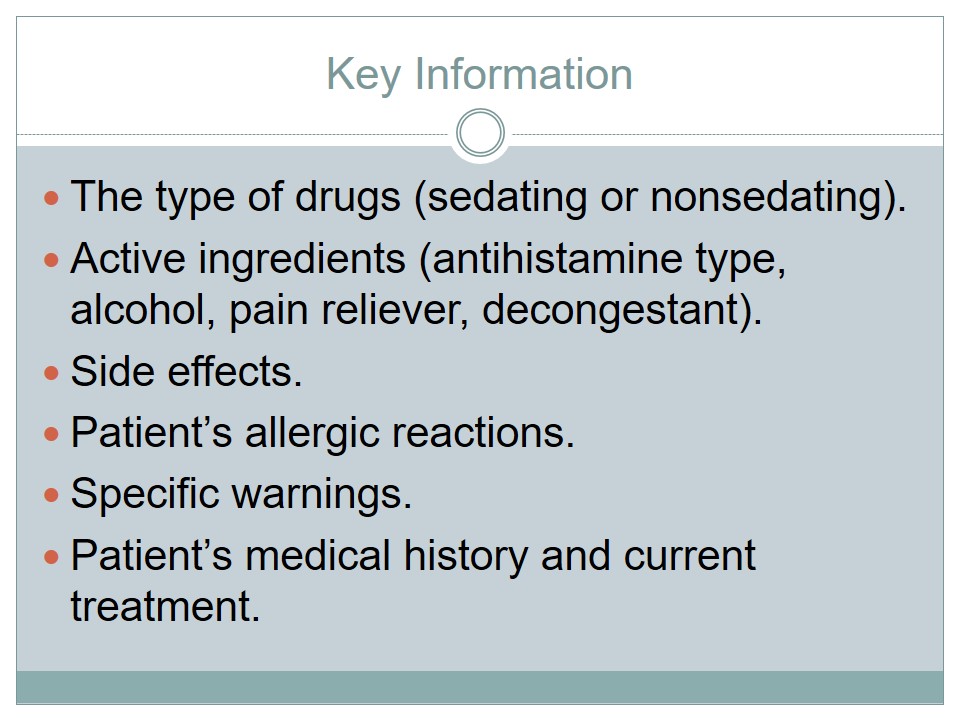
Potential Interactions
- First-generation drugs can cause drowsiness and should be avoided (AGS, 2015).
- Antihistamines may negatively affect older patients’ vision and cognitive skills.
- Alcohol-based medications may increase the fall risk (Milos et al., 2014).
- Polypharmacy using incorrect OTC antihistamines can lead to urinary, respiratory, and cardiovascular problems.
According to the American Geriatrics Society’s updates Beers criteria (AGS, 2015), all first-generation antihistamines should be avoided by older patients due to a number of reasons. First of all, older people’s bodies can hold the medication for long periods of time, increasing its activity. Thus, these drugs do not leave the circulation and may have a cumulative effect. Furthermore, their ability to cross the blood-brain barrier negatively affects cognitive functions of people, increasing drowsiness and causing blurred vision (Milos et al., 2014). Second- and third-generation antihistamines do not have a similar effect. Nonetheless, they should also be recommended cautiously.
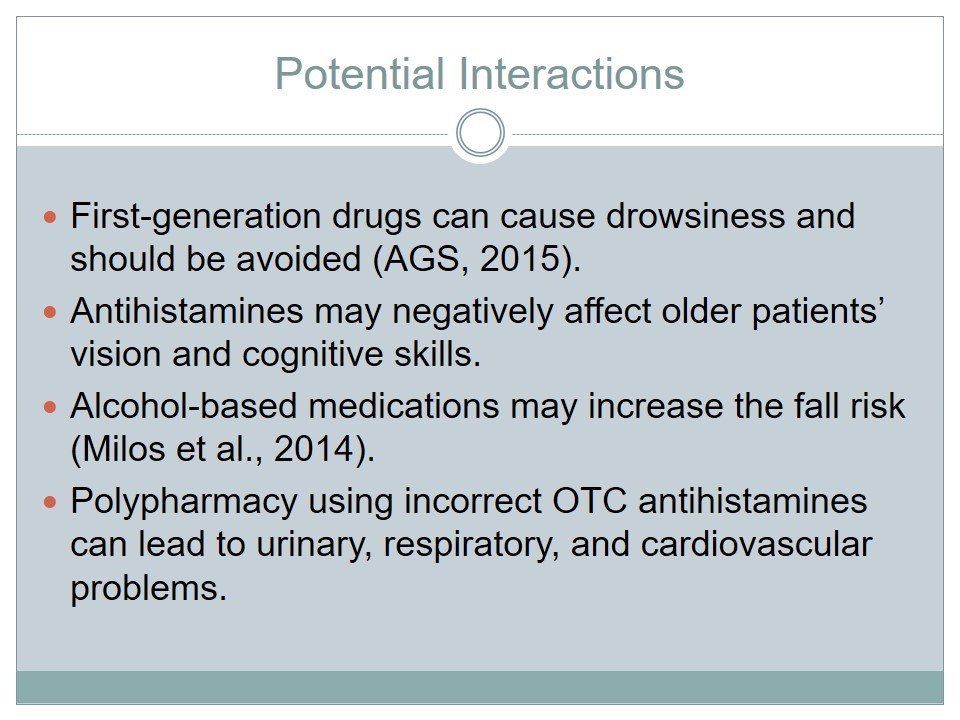
Elders’ Education
- Older people can choose drugs with loratadine and cetirizine.
- Medications should not contain pain relievers or decongestants if these drugs are already used in the treatment plan.
- Antihistamines should not be consumed with alcohol.
- It is necessary to adhere to the recommended dosage.
- Ones’ medical history can reveal some additional warnings and allergies.
It is necessary to explain to older people that antihistamines can make them drowsy even if consumed correctly. They should learn about common side effects and possible limitations (allergies and affected conditions). Furthermore, one should highlight the need to adhere to the proposed dosage based on the older person’s previous history and current drug therapy. Finally, older patients should be warned against using first-generation antihistamines.
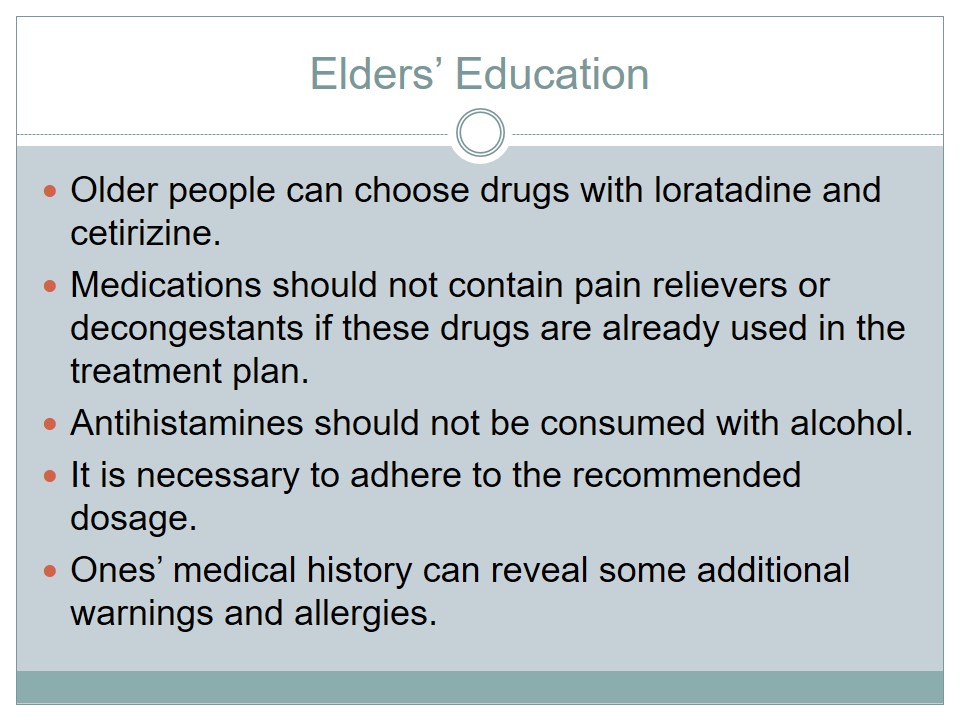
Conclusion
- Antihistamines can be sedating and nonsedating.
- Older people should avoid sedating antihistamines (first generation).
- Antihistamine drugs can include pain relievers and decongestants.
- They often cause drowsiness and nausea.
- One cannot consume alcohol with antihistamines.
Antihistamines are mostly used by people to treat allergic reactions and disorders. Older people should choose OTC antihistamines cautiously, avoiding first-generation drugs and making sure that the ingredients do not include additional doses of pain relievers and decongestants. They should be prepared to handle some side effects and contact their healthcare provider if they have other conditions that may be affected by this medication.
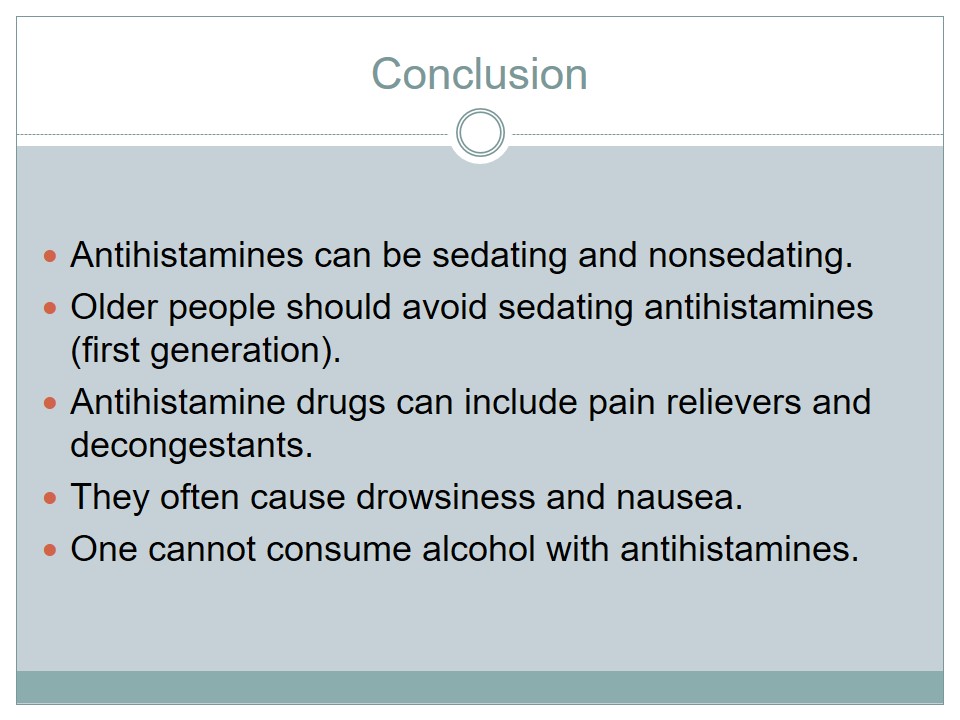
References
American Geriatrics Society [AGS]. (2015). Updated Beers criteria for potentially inappropriate medication use in older adults. Web.
Aviva. (2010a). An allergic reaction. Web.
Aviva. (2010b). Antihistamines reducing the reaction. Web.
GCV Business Journal. (2018). Forms of medicine. Web.
Healthline. (2018). Types of OTC drugs. Web.
Holroyd-Leduc, J., & Reddy, M. (Eds.). (2012). Evidence-based geriatric medicine: A practical clinical guide. Hoboken, NJ: Blackwell Publishing.
Milos, V., Bondesson, Å., Magnusson, M., Jakobsson, U., Westerlund, T., & Midlöv, P. (2014). Fall risk-increasing drugs and falls: A cross-sectional study among elderly patients in primary care. BMC Geriatrics, 14(40), 1-7.
National Institutes of Health [NIH]. (2017). Drug record: Antihistamines. Web.
Resnick, B. (Ed.). (2016). Geriatric nursing review syllabus: A core curriculum in advanced practice geriatric nursing (5th ed.). New York, NY: American Geriatrics Society.
Schellack, N., Schellack, G., & van Rensburg, M. J. (2015). An overview of anti-allergic drug therapy and the histamine-1 antihistamines. South African Family Practice, 57(1), 43-49.